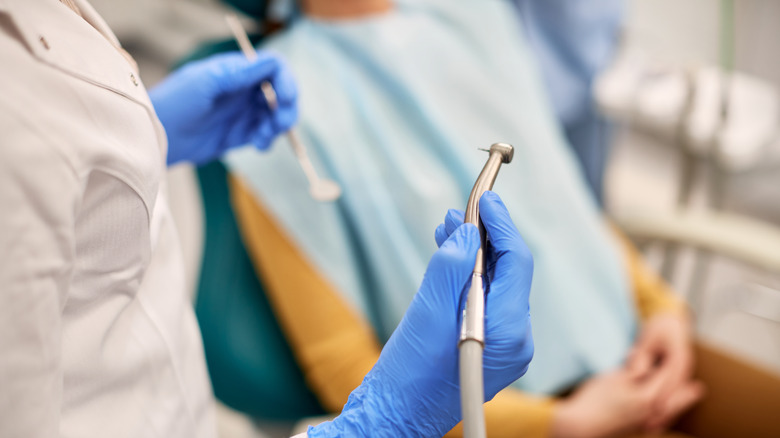How Soon Can You Eat After Getting A Filling?
As a child, you probably heard the warning that too much sugar will rot your teeth out. However, sugar is only one half of the equation. According to the National Institute of Dental and Craniofacial Research, when we combine sugar or starch from the food items we eat with the plaque-related bacteria in our mouth, together they produce an acid. It's this acid exposure that can gradually cause more and more damage to tooth enamel, sometimes leading to a dreaded cavity.
Treatment for a cavity involves removing the damaged tissue within the tooth and replacing it with a dental filling. Filling material can range from plastic to metal, glass, gold, porcelain, and more (via Cleveland Clinic). Depending on the material used, some fillings may last for more years than others. While the duration of the procedure can vary based on the type of filling, it can often be completed in one session. So what can one expect when getting a filling, and how long do you have to wait before you can eat?
How the procedure works
To start, the site surrounding the affected tooth will be numbed with a local anesthetic so the patient won't feel any pain (via Cleveland Clinic). The decayed tissue will then be removed with a specialized tool. This will either be a drill, laser, or air abrasion instrument. Once it's been confirmed that all of the damaged tissue has been eliminated, the space will be cleaned to ensure it's void of bacteria, food particles, or other contaminants. A protective liner of additional filling material may first be added if the damage is in close proximity to the nerve. For those receiving tooth-colored composite fillings, your dentist will layer in the filling material and use a dental curing light to harden each layer before polishing off the finished product.
All that drilling certainly works up an appetite, doesn't it? If you received a composite filling, the good news is that you're able to eat as soon as you like. Because the filling was hardened with a UV light, there are no limitations when it comes to temperature, or hard versus soft foods, according to Wilkinson Dental. However, if you're still feeling numb following the procedure, your dentist may advise holding off on eating or drinking for about two hours until the anesthesia fully wears off (per Rely Dental and Orthodontics).
Patients who receive a silver filling, however, will want to avoid chewing on the affected tooth for 24 hours after the procedure, at which time it will be fully hardened.
You can eat immediately, but with a few caveats
For some patients, however, it is not unusual to experience some minor side effects after receiving a filling. This may include sensitivity to cold or hot temperatures, which can sometimes last upwards of 14 days following the procedure (via Wilkinson Dental). In this event, avoid overly hot or cold food items, as well as hard foods that may apply added pressure and discomfort around the tooth. Now may not be the time to chomp down on a cup of ice chips, for instance.
If you are experiencing minor side effects following a filling, stick to foods like lukewarm soup or scrambled eggs, advises Rely Dental and Orthodontics. Additionally, steer clear of highly acidic foods, as one is more susceptible to infection in the aftermath of a filling. Finally, you may want to refrain from chewing on any particularly sticky or gummy food items, as you run the risk of displacing the filling.



